Salidroside
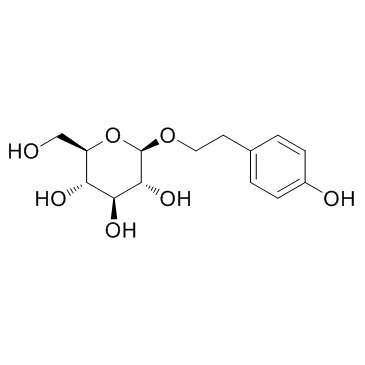
Salidroside structure
|
Common Name | Salidroside | ||
|---|---|---|---|---|
| CAS Number | 10338-51-9 | Molecular Weight | 300.304 | |
| Density | 1.5±0.1 g/cm3 | Boiling Point | 549.5±50.0 °C at 760 mmHg | |
| Molecular Formula | C14H20O7 | Melting Point | N/A | |
| MSDS | Chinese USA | Flash Point | 286.2±30.1 °C | |
| Symbol |

GHS07 |
Signal Word | Warning | |
| Purity | Quantity | Budget | Inquiry |
|---|
Use of SalidrosideSalidroside is a prolyl endopeptidase Inhibitor. Salidroside alleviates cachexia symptoms in mouse models of cancer cachexia via activating mTOR signalling. |
| Name | Salidroside |
|---|---|
| Synonym | More Synonyms |
| Description | Salidroside is a prolyl endopeptidase Inhibitor. Salidroside alleviates cachexia symptoms in mouse models of cancer cachexia via activating mTOR signalling. |
|---|---|
| Related Catalog | |
| Target |
mTOR |
| In Vitro | Salidroside (100 μM) inhibits prolyl endopeptidase (PEP) activity (10.6±1.9%). Prolyl endopeptidase is an enzyme that plays a role in the metabolism of proline-containing neuropeptidase which is recognized to be involved in learning and memory[1]. Salidroside, one of the major phenylpropanoid glycosides found in R. rosea L, is consumed almost daily as a nutritional supplement in many countries and has been identified possessing potential anti-fatigue and anoxia,anti-aging, and anti-Alzheimer's disease activities. Salidroside can improve muscle nutrition via increasing mTOR, p-mTOR, and MyHC expression[2]. SH-SY5Y cells are exposed to 0-600 μM MPP+ for 12-48 h and the results show that MPP+ results in a significant decrease of cell viability in a concentration and time-dependent manner. Cells are pretreated with 25-100 μM Salidroside (Sal) for 24 h and then exposed to 500 μM MPP+ for an additional 24 h. Salidroside concentration-dependently prevents MPP+-induced decrease of cell viability. Annexin V/PI staining is a common method for the detection of apoptotic cell. Salidroside significantly decreases the number of Annexin V/PI-stained cells treated by MPP+ which is in a concentration-dependent manner. Apoptotic cell could also be morphologically evaluated by Hoechst staining. In Hoechst staining, apoptotic cells are characterized by reduced nuclear size, chromatin condensation, intense fluorescence, and nuclear fragmentation. Salidroside notably inhibits MPP+-induced increase of chromatin condensation, intense fluorescence, and nuclear fragmentation in SH-SY5Y cells[3]. |
| In Vivo | Salidroside is a natural antioxidant extracted from medicinal food plant Rhodiola rosea. Salidroside (100 mg/kg/day) shows strong glucose lowering effect on db/db mice which is similar to effect of Metformin (200 mg/kg/day). For this reason, the dose of 100 mg/kg/day salidroside is used[4]. |
| Cell Assay | SH-SY5Y cells are seeded in 96-well plates at 1×104 cells per well. After the treatment with Salidroside (25-100 μM) and MPP+, cell viability is measured by MTT assay. Briefly, cells are incubated with 500 μg/mL MTT at 37°C for 4 h. After that, the medium is removed and 150 μL DMSO is added and shaking is conducted for 10 min. Absorbance is measured at 570 nm in a microplate reader and the results are expressed as folds of control[3]. |
| Animal Admin | Mice[4] The 4-week-old male C57BL/6 mice are fed a high-fat diet (HFD) (n=16) or normal chow diet (n=8). After 10 weeks of the HFD, salidroside intervention (100 mg/kg/day) is initiated by gavage once a day for 5 weeks. The control groups are given vehicle (saline). The 4-week-old male C57Bl/KsJ (BKS) mice (wild type, n=8) and BKS.Cg-Dock7m +/+ Leprdb/J (db/db) mice (n=16) are used. Salidroside (100 mg/kg/day) is administrated orally by gavage once a day for 5 weeks. The control groups are given vehicle (saline). Fasting blood glucose and body weight of mice are monitored every 5 days. Glucose measurements are performed on blood drawn from the tail vein using a Glucometer. |
| References |
| Density | 1.5±0.1 g/cm3 |
|---|---|
| Boiling Point | 549.5±50.0 °C at 760 mmHg |
| Molecular Formula | C14H20O7 |
| Molecular Weight | 300.304 |
| Flash Point | 286.2±30.1 °C |
| Exact Mass | 300.120911 |
| PSA | 119.61000 |
| LogP | -1.23 |
| Vapour Pressure | 0.0±1.6 mmHg at 25°C |
| Index of Refraction | 1.629 |
| Storage condition | ?20°C |
CHEMICAL IDENTIFICATION
HEALTH HAZARD DATAACUTE TOXICITY DATA
|
| HS Code | 2932999099 |
|---|---|
| Summary | 2932999099. other heterocyclic compounds with oxygen hetero-atom(s) only. VAT:17.0%. Tax rebate rate:13.0%. . MFN tariff:6.5%. General tariff:20.0% |
|
A pH-responsive nano-carrier with mesoporous silica nanoparticles cores and poly(acrylic acid) shell-layers: fabrication, characterization and properties for controlled release of salidroside.
Int. J. Pharm. 446(1-2) , 153-9, (2013) A novel pH-responsive nano-carrier MSNs-PAA, possessing mesoporous silica nanoparticles (MSNs) cores and poly(acrylic acid) (PAA) shell-layers, was developed for controlled release of salidroside. The... |
|
|
Inhibitory effects of salidroside and paeonol on tyrosinase activity and melanin synthesis in mouse B16F10 melanoma cells and ultraviolet B-induced pigmentation in guinea pig skin.
Phytomedicine 20(12) , 1082-7, (2013) Salidroside, the major active component of Rhodiola rosea, a herb with antioxidant, free radical scavenging and tyrosinase inhibitory effects, has been recently reported in protecting the kerationcyte... |
|
|
Salidroside protects retinal endothelial cells against hydrogen peroxide-induced injury via modulating oxidative status and apoptosis.
Biosci. Biotechnol. Biochem. 79 , 1406-13, (2015) Oxidative stress can cause injury in retinal endothelial cells. Salidroside is a strong antioxidative and cytoprotective supplement in Chinese traditional medicine. In this study, we investigated the ... |
| SALIDROSIDE RHODIOLOSIDE |
| MFCD00210553 |
| 2-(4-Hydroxyphenyl)ethyl α-D-glucopyranoside |
| RHODIOLOSIDE |
| Salisorosides Rosavin |
| Salidroside |
| RhodiolaCrenulataExtract |
| rhodosin |
| TWEEN 20 EXTRA PURE |
| β-D-Glucopyranoside, 2-(4-hydroxyphenyl)ethyl |
| 2-(4-Hydroxyphenyl)ethyl β-D-glucopyranoside |
| α-D-Glucopyranoside, 2-(4-hydroxyphenyl)ethyl |
| RHODIOLAEXTRACT |
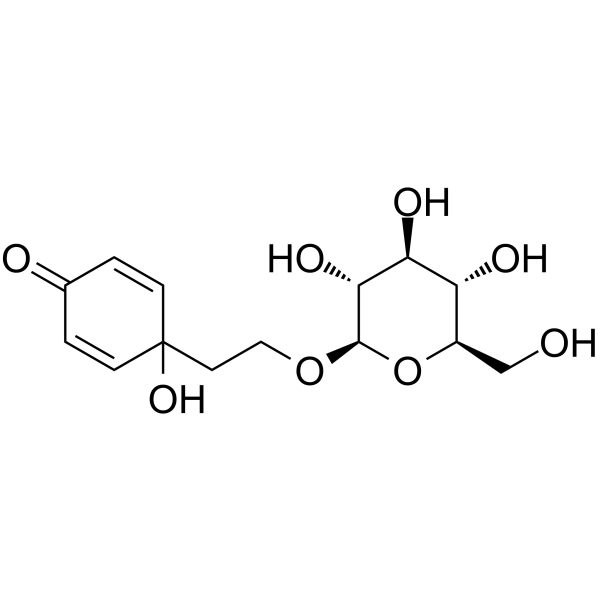 CAS#:40661-45-8
CAS#:40661-45-8 CAS#:67-56-1
CAS#:67-56-1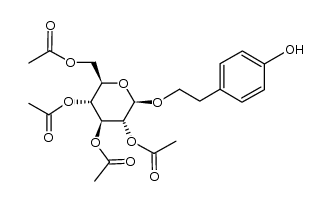 CAS#:28251-63-0
CAS#:28251-63-0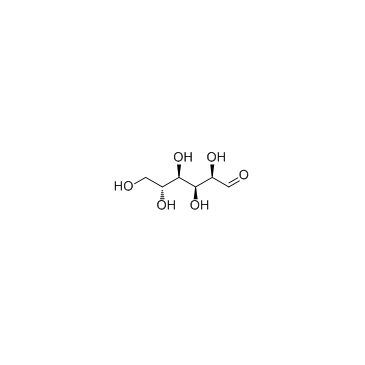 CAS#:50-99-7
CAS#:50-99-7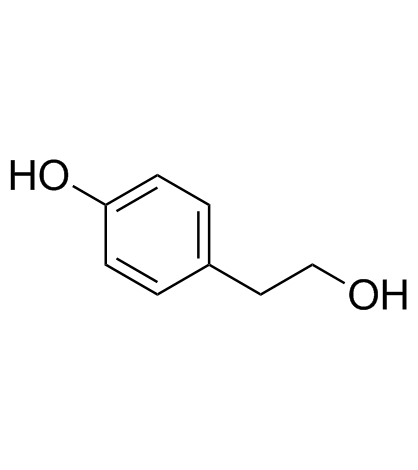 CAS#:501-94-0
CAS#:501-94-0 CAS#:2492-87-7
CAS#:2492-87-7 CAS#:133-99-3
CAS#:133-99-3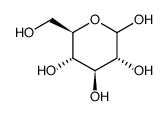 CAS#:492-62-6
CAS#:492-62-6
